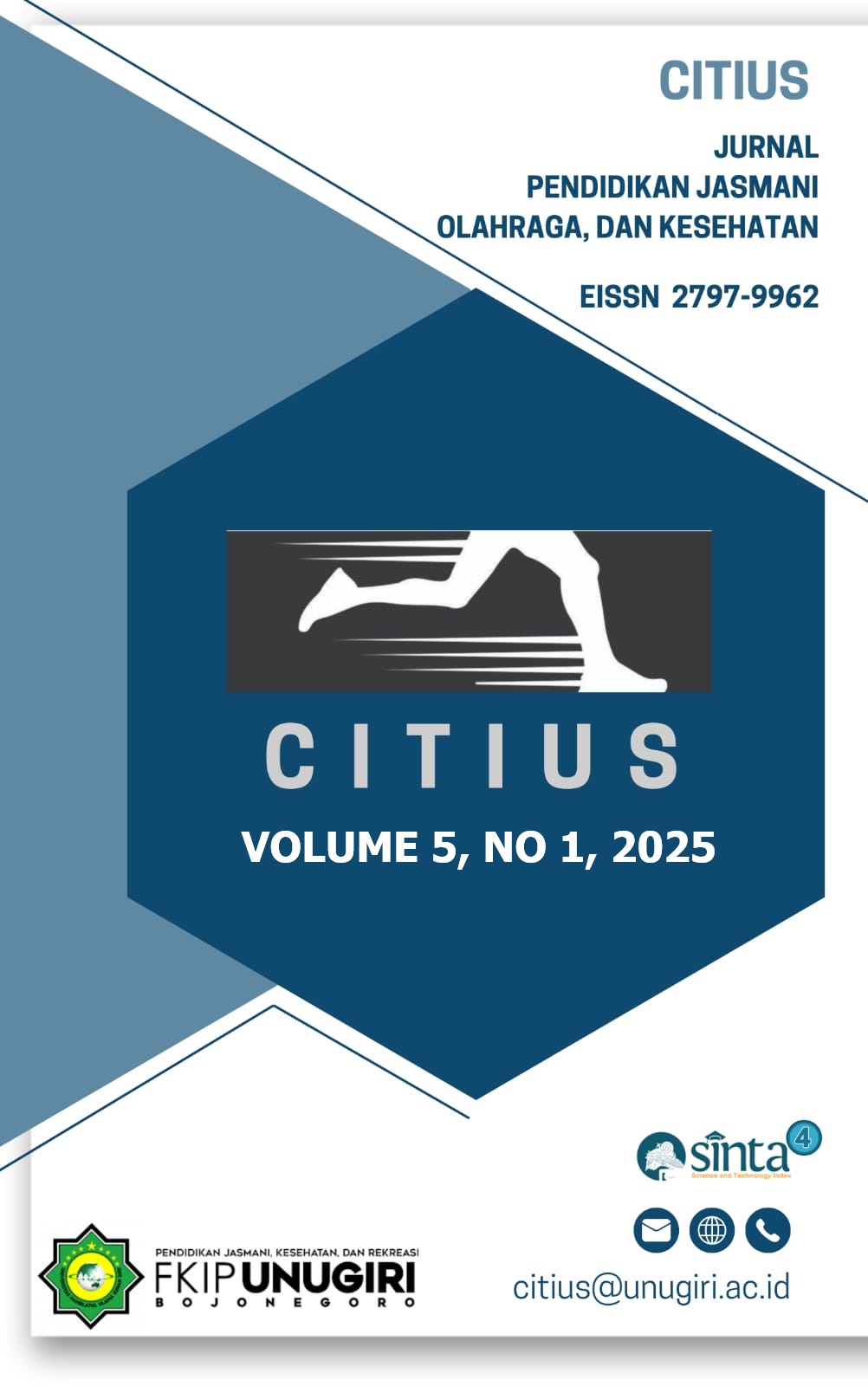The effect of mechanical feedback on the learning and retention of selected gymnastics skills Among female students
 PDF Download: 112
SIMILARITY CHECK Download: 87
PDF Download: 112
SIMILARITY CHECK Download: 87
DOI:
https://doi.org/10.32665/citius.v5i1.4441Keywords:
gymnastics, biomechanics, mechanical feedback, motor learning, skill acquisition, sports science.Abstract
Technological advances in sports have opened up new opportunities to enhance the efficiency of learning motor skills, including gymnastics. This study found that mechanical feedback improves movement accuracy, speeds up the learning process and reduces performance variability compared to traditional methods. The study examined the impact of real-time mechanical feedback on the acquisition and retention of preferred gymnastics skills among students at the College of Physical Education and Sports Science at the University of Baghdad. A quasi-experimental design was used, with 40 students divided into two groups: an experimental group of 20 students who received mechanical feedback and a control group of 20 students who were trained using traditional methods. Data were collected through pre- and post-workout tests, as well as a retention test, to evaluate skill mastery, execution precision, and endurance. The results showed that mechanical feedback significantly improved movement execution and skill retention compared to the control group. In conclusion, technology-based mechanical feedback has the potential to be an effective training tool in sports, supporting improved performance through better motor control. Further research is needed to explore the long-term effects of mechanical feedback and the integration of artificial intelligence technology in training systems, as well as its effect on psychological and cognitive factors such as motivation, focus and athlete confidence.
References
Abbas, I. A. K., Mushref, A. J., & Shalash, M. J. A. (2024). The effect of corrective exercises accompanied by mechanical feedback on some kinematic indicators and learning how to perform volleyball spiking for students. مجلة دراسات وبحوث التربية الرياضية, 342-360.
Al Ardha, M. A., Nurhasan, N., Nur, L., Chaeroni, A., Bikalawan, S. S., & Yang, C. B. (2024). Analysis of Android-based applications in physical education and sports: Systematic review. Retos: nuevas tendencias en educación física, deporte y recreación, (57), 390–398.
Al-Azzawi, S. M., & Al-Bayati, B. A. (2013). Applied artistic gymnastics. Dar Al-Dhiaa for Publishing.
Al-Dulaimi, N. A. Z., & Al-Shammari, M. A. (2018). Motor learning. Safaa Publishing and Distribution.
Al-Fadhli, S. A. K. (2010). Applications of biomechanics in sports training and motor performance. Dar Dijla for Printing and Publishing.
Al-Fadhli, S. A. K., Hassan, I. D., & Othman, M. J. (2017). Visual feedback through visual monitoring to correct performance and develop some biomechanical indicators of hammer throw for advanced athletes. Journal of Physical Education Sciences, 10(1).
Al-Jaafreh, O. J., & Qawaqzeh, S. S. A. (2024). The importance of understanding kinesiology for gymnastics: A biomechanist's perspective. SPORT TK - Revista EuroAmericana de Ciencias del Deporte, 28, 28.
Ávalos Ramos, M. A., & Vega Ramírez, L. (2022). Diagnosis and trend in the acquisition of gymnastic and acrobatic skills in high school.
Blynova, O., Popovych, I., Hulias, I., Radul, S., Borozentseva, T., Strilets-Babenko, O., & Minenko, O. (2022). Psychological safety of the educational space in the structure of motivational orientation of female athletes: A comparative analysis. Journal of Physical Education and Sport, 22(11), 2723–2732.
Ghafoor, T. M., & Jalal, N. M. (2022). The effect of mechanical feedback on the success and failure rate during competitions for the jump serve skill in volleyball for advanced players. In The 8th International Scientific Conference on Sports Science and Technology. College of Physical Education and Sports Sciences, University of Babylon.
Hasan, U. C., & Hasan, E. E. S. (2022). Effect of delayed mechanical feedback on long jump performance. Human Movement, 23(4), 140–147.
Khiyon, Y. A. H. (2011). Motor learning between principle and application. Sahara Office.
Knoll, K. (2002). The kinematic dynamic structure of effective giant swings backward before difficult dismounts and flight elements on horizontal bar and uneven bars. University of Extremadura.
Moon, J., & Park, Y. (2023). Evaluation of assessment techniques for preservice physical education teachers in volleyball skills during blended learning. Journal of Physical Education and Sport, 23(3), 648–657.
Morsalfard, S. N., Nasermeli, M. H., & Namina, B. G. (2023). Comparison of the traditional training method to teach handstand and training through a researcher-made device and their impact on the handstand duration, pain and quality of performance in 8–10-year-old beginner gymnast girls. Science of Gymnastics Journal, 15(3), 395–407.
Richard, A. (2011). Motor control and performance: Concepts and applications (9th ed.). M.C. Craw.
Saleh, B. T. Q., & Ghafoor, T. M. (2023). The effect of mechanical feedback according to kinetic analysis in developing the forehand and backhand spiral stroke in table tennis for advanced players. Journal of Sports Sciences, 14(55).
Sorzano, S. (2023). How spotting with touch affects skill performance and self-confidence in gymnasts (Master’s thesis, Trent University, Canada).
Starzak, M., Biegajło, M., Nogal, M., Niźnikowski, T., Ambroży, T., Rydzik, Ł., & Jaszczur-Nowicki, J. (2022). The role of verbal feedback in the motor learning of gymnastic skills: A systematic review. Applied Sciences, 12(12), 5940. https://doi.org/10.3390/app12125940
Zemková, E., & Kováčiková, Z. (2023). Sport-specific training induced adaptations in postural control and their relationship with athletic performance. Frontiers in Human Neuroscience, 16, 1007804. https://doi.org/10.3389/fnhum.2022.1007804
Zghibi, M. (2024). Serious game for learning gymnastic elements: Preliminary development and validity assessment.
Downloads
Published
Issue
Section
 PDF Download: 112
SIMILARITY CHECK Download: 87
PDF Download: 112
SIMILARITY CHECK Download: 87








